
No ammo. No range. No Problem. A dry fire training system allows you to keep your skills sharp in the confines of your own home. Here are five areas to work on.
What Should Be Part Of A Dry Fire Training System:
Competency with a defensive handgun is a perishable skill. You need to practice on a regular basis to improve or just remain proficient. That takes time and money, and time and money are the two things most of us have the least. For many, a trip to the range can consume a half or full day, and with range fees and ammunition, it can cost a hundred bucks or more. What might surprise you, especially if you’re a new shooter, is that you can practice the most important of those perishable skills at home, without ammunition.
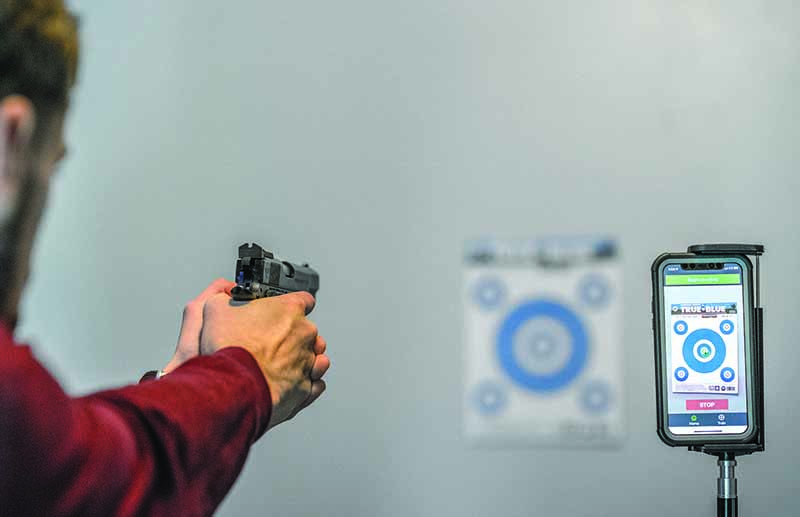
Typically, this type of practice is called dry practice or dry-fire practice, meaning, it’s practice without ammunition. Too often shooters don’t give dry practice the credit it deserves. This is probably partly because dry practice is boring, but mostly because dry practice is very boring. However, just because it’s boring does not mean it’s not helpful. In fact, almost every athletic endeavor—shooting is an athletic endeavor—can be improved with some form of dry practice.
Here are five of the most critical aspects of employing a defensive handgun in an effective manner that can be improved upon without ever firing a single shot. All these practices can be conducted at home for a few minutes each day to create a fruitful dry fire training system. You just need to find a safe place where you’re undisturbed, make sure your handgun is—for damn sure—unloaded, that there’s no ammunition around and concentrate.
Firearm Presentation
Being able to get your pistol out of your holster and orientated toward the threat quickly and efficiently is a critical aspect of weaponcraft with regard to the defensive handgun. It starts with clearing the cover garment and establishing a shooting grip while the handgun is in the holster. It ends with the handgun properly orientated with the sights on the target. A great way to work on this is with a shot timer and a smartphone.
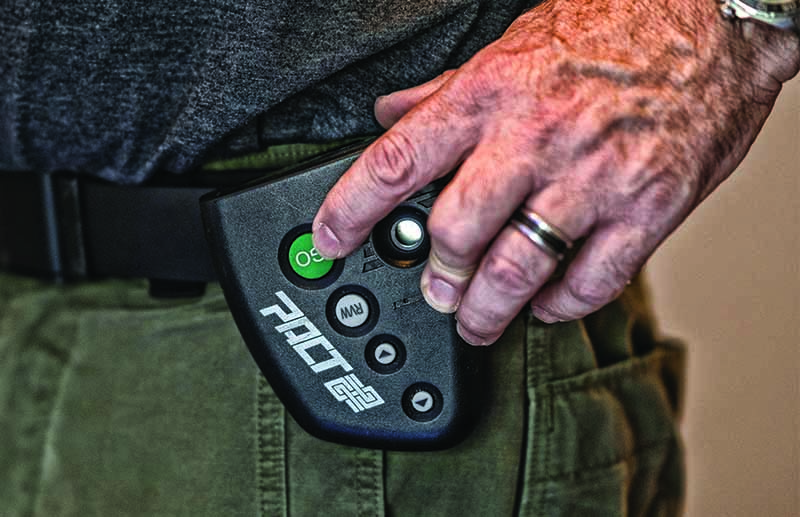
A shot timer, such as the PACT Club Timer, comes with a par time feature. This par time feature allows you to set the shot timer to beep after a certain amount of time. It also has a delay start feature. Set the delay start and par time to 3 seconds and stand ready with your handgun concealed as you most often carry it.
At the signal, draw the handgun, present it toward the target, and make a trigger press when the sights are properly aligned. Your goal is to accomplish this before you hear the second beep, which will occur 3 seconds after the first. You can then gradually adjust the par time, with the ultimate goal of getting it down to about 1 second.
The smartphone can be used to video your draw stroke. To do this, you’ll need a helper, or you can also use a tripod and a smartphone mount. G-Sight, which manufacturers a device we’ll discuss shortly, also makes a tabletop tripod and smartphone mount that works great for this. You can record your draw stroke in real-time or even slow motion. The idea is to watch your draw stroke to make sure you’re performing each step correctly.
More Firearms Training And Drills:
- Competition Shooting Vs Defensive Training
- Gun Digest’s 10 Best Shooting Drills And Firearms Training Posts
- 6 Defensive Handgun Drills to Master
- 5 AR-15 Drills That Will Help You Master Your Rifle
- How-To: AR-15 Dry Fire Drills
- Handgun Drills: The Things To Practice
Holstering
Putting your handgun back into your holster is also very important. Why? This is the activity that most often results in self-inflicted gunshot wounds. Because holsters that cover the trigger guard and inside the waistband (IWB) carry are so popular, and because shooters often forget to remove their finger from the trigger guard when they holster, the holster or the waistband presses against the finger, the finger presses against the trigger, and the gun goes bang. This is often accompanied by a scream and a fluent expression of profanity.
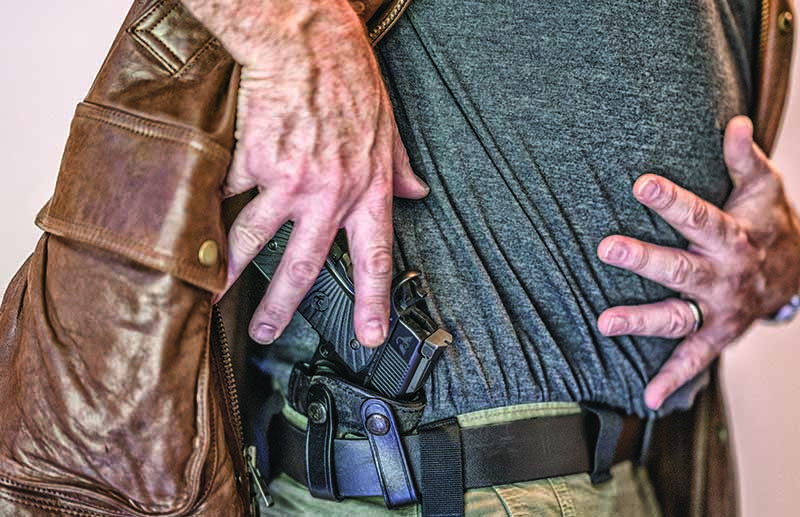
Many instructors teach that you should be able to holster your handgun without looking at the holster. There are times when this could be a valuable skill, particularly in law enforcement, but for the civilian shooter, the frequency of needing to holster without looking is rare.
Every dry practice session should include at least 20 or so repetitions of the slow and methodical holstering of your handgun. This will condition you to holster your handgun slow and methodically. The need to holster in a hurry is just as rare as needing to holster without looking. On the upside, by the repetitive practice of holstering your handgun, you’ll eventually be able to do it—if you feel the need to—without looking.
Sight Alignment and Trigger Control
The secret to shooting accurately is really no secret at all; it’s simply the proper alignment of the sights and a trigger press that doesn’t disturb that alignment. This is something that dry practice can definitively improve upon, and there are several inexpensive ways to do it.
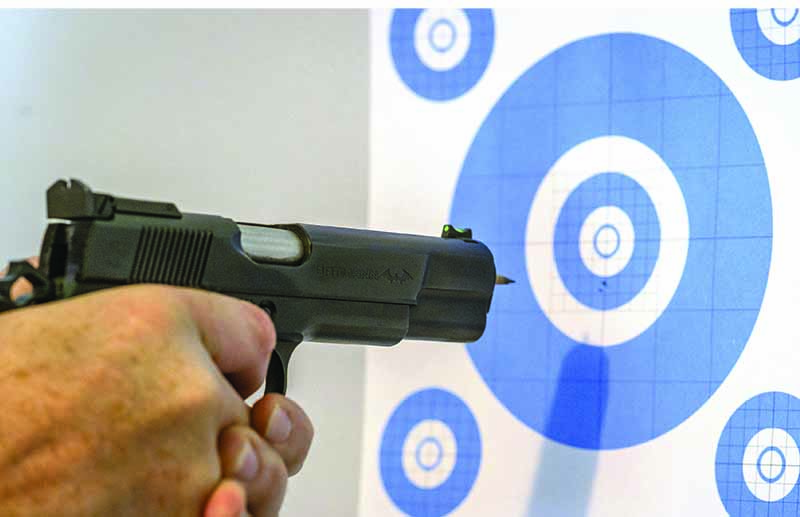
One of the oldest methods is to draw a small target about the size of a pencil eraser on a sheet of notebook paper and tape it to the wall. Alternatively, you can just tape a target to the wall. Then, insert a sharpened pencil in the barrel of the handgun. Next, aim at the target, with the pencil about an inch from the target, and press the trigger. The pencil will make a dot on the target when the hammer hits the eraser and pushes it out of the barrel. Do this about five times and you’ll have a five-shot—pencil dot—group on the paper. The goal is for all the pencil dots to be in the same place.
Another technique is to balance a dime on top of the pistol’s slide or barrel. This won’t work on Glocks or other pistols with flat slides. But, with handguns with rounded slides or exposed barrels, place the dime on the barrel or slide, establish a sight picture, and press the trigger without letting the dime fall off.
A more modern approach is to use a device like the one offered by G-Sight. Their Expert Laser Marksman System is a laser module that fits inside the chamber of your pistol. When you press the trigger, the device emits a laser flash that you can see on the target. One of the things that makes the ELMS system so revolutionary is that when combined with their G-Sight LTP app, the camera on your smartphone records these laser flashes on the target.
After firing a 10-shot group you can review those imaginary bullet impacts—laser flashes—on your smartphone. You’ll need the tripod and phone mount mentioned earlier, and G-Sight offers several affordable options. In fact, a complete system with the ELMS, tripod and mount retails for as little as $110.
Malfunctions
Being able to keep your pistol operational is a highly desirable skill. Stoppages/malfunctions occur and that guy by the name of Murphy tends to ensure they occur at the least opportune moment. You prepare for these moments by staging stoppages in your handgun and clearing them. The best way to learn how to clear stoppages is with dummy rounds.

A common dummy round inserted in the chamber of your handgun will simulate a failure to fire. A new dummy round called the Type 3 Malfunction Round, does a great job of simulating a more complex stoppage where—for a variety of reasons—a cartridge fails to fully chamber.
By setting up these stoppages at home and going through the clearing procedures, you can create a conditioned response. Then, when you’re on the range conducting live-fire, you can use these dummy rounds—spaced throughout your magazines—to create stoppages you’re not expecting. If you’ve done your dry-fire homework, you’ll be ready to further train to create an even more conditioned response to stoppages.
Reloading
It’s a fact that most actual defensive handgun engagements involving civilians rarely exceed the expenditure of more than a single load. In other words, most defensive handgun engagements are over before a reload is required or conducted. That, however, doesn’t mean reloading your handgun with speed and grace is something you shouldn’t learn to do. In fact, sometimes a reload is the best way to deal with a stoppage. A shot timer can help you develop this skill so that you can accomplish the task faster.
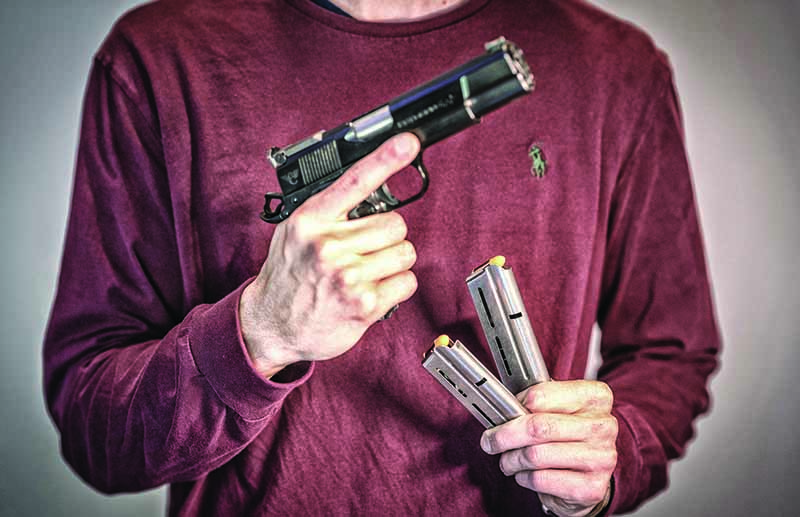
Set the par time on the shot timer to about 4 seconds. Then, fill up several magazines with dummy rounds, put one in the gun and the rest in your magazine pouches or wherever you normally carry them. Now, with the handgun orientated toward the target, when you hear the start signal on the timer, conduct a reload.
There are essentially three different types of reloads to practice. With the speed reload, you’re simply ejecting one magazine and inserting a new one. With the slide-lock reload, you start with the gun in slide lock and then eject the magazine, insert a new one and drop the slide. For the tactical reload, you retain the partially expended magazine that’s in the gun—for potential later use—and insert a new one.
You can work on all of these reload techniques with the par time feature on the shot timer. For speed and slide-lock reloads, a good goal is something between 2 and 3 seconds. For a tactical reload, time isn’t so much of a concern because you should only conduct a tactical reload when you have time.
Frequency Of Practice
So, how much of your week should your dry fire training system monopolize? I dry practice every day. It might only be four or five trigger presses or presentations, or I may spend as long as 20 minutes working on sight alignment and trigger control, immediate action or reloading. Handling your handgun every day, even for just a few moments, gets you more familiar with it. If you can do it without the adverse expenditure of time or money, it only makes sense.
But don’t overlook the assistance dry-fire practice can provide in conjunction with a trip to the range for live fire. Intermingling dry fire with live fire while on the range can help you get the most out of the time and money you’re spending, while actually making loud noises.
As a final consideration and reminder: safety first. When conducting any form of dry practice, make sure your handgun is unloaded, that no live ammunition is anywhere near you and that you’re always pointing your handgun in a safe direction. Bullet holes in your television, family members or yourself have a way of creating a bad day. Being humans of sound mind and caring nature, that’s something we like to avoid.
Editor's Note: This article originally appeared in the 2020 EDC issue of Gun Digest the Magazine.

Next Step: Get your FREE Printable Target Pack
Enhance your shooting precision with our 62 MOA Targets, perfect for rifles and handguns. Crafted in collaboration with Storm Tactical for accuracy and versatility.
Subscribe to the Gun Digest email newsletter and get your downloadable target pack sent straight to your inbox. Stay updated with the latest firearms info in the industry.

![Best Concealed Carry Guns In 2025 [Field Tested] Wilson Combat EDC X9S 1](https://gundigest.com/wp-content/uploads/Wilson-Combat-EDC-X9S-1-324x160.jpg)


![Best 9mm Carbine: Affordable PCCs [Tested] Ruger Carbine Shooting](https://gundigest.com/wp-content/uploads/Ruger-Carbine-Shooting-100x70.jpg)
![Best AR-15: Top Options Available Today [Field Tested] Harrington and Richardson PSA XM177E2 feature](https://gundigest.com/wp-content/uploads/Harrington-and-Richardson-PSA-XM177E2-feature-100x70.jpg)
